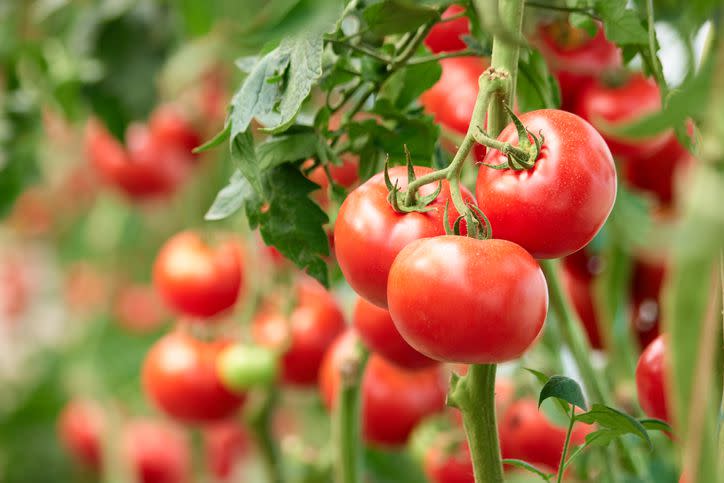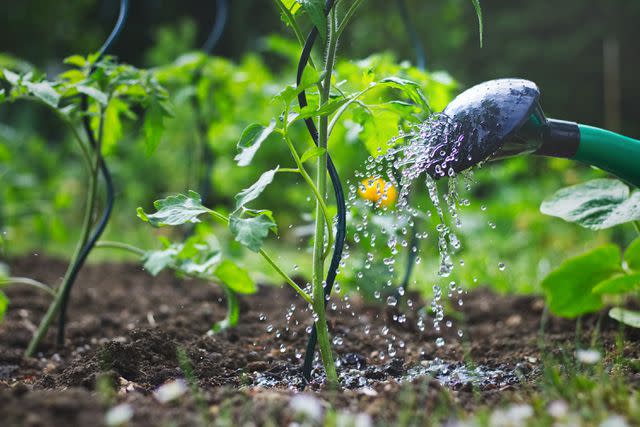Here's How Often You Should Really Be Watering Your Tomatoes, According To An Expert
Perfectly vine-ripened tomatoes have to rely on more than sunshine.

Getty Images/Denisfilm
Nothing beats a juicy, ripe tomato at the height of summer and, if you're lucky, you'll end up with enough tomatoes to feed the whole neighborhood (and the squirrels, too). But that luck comes from knowing exactly the right care and maintenance for your plants; the most important being how often to water your tomatoes.
Tomatoes are generally known as easy-to-grow, but watering is where things can go awry. There's a little bit of Goldilocks involved in getting just the right watering frequency for your tomatoes. Water too much, and you could end up with soggy roots and rotten tomatoes. Water too little, and you could end up with a less-than-stellar harvest.
Determining the right watering schedule can depend on soil conditions, where your tomatoes are planted, and your climate. If you want to make sure you water your tomato plants correctly this summer, here's the expert-approved guide on frequency, factors in watering, and how to recognize overwatering and underwatering.
Meet The Expert
Rebecca Sears is Resident Green Thumb at Ferry-Morse.
Which Factors Determine Watering Frequency?
Not all tomato plants are growing under the exact same conditions. This is true from state to state where soil and climate vary greatly. But it can even be true in the same neighborhood. Your tomato plants might need to be watered more often than your neighbor's, solely because of the container you chose or the soil you used.
Climate
The hotter and drier it is, the more often your tomato plants will need to be watered. In extreme heat, tomatoes in containers will need to be watered daily. If it's dry on top of the heat, then you may need to increase it to twice daily.
Soil
Soil is the most critical piece of determining watering frequency because your soil is the key to retaining water. "Sandy soil drains easily, and tomato plants grown in sandy soil will need watering three to four times per week. Soils with more clay hold water, so watering once per week is usually sufficient," says Rebecca Sears, Resident Green Thumb at Ferry-Morse.
Container
When a tomato plant is in the ground, there are more water reserves to draw from and, typically, deeper roots to reach further into the ground. But, in a container, all it has is recent rainfall or the water you feed it. "Container plants tend to dry out faster and therefore may require more frequent watering to keep the soil moist," says Sears.
To help tomatoes in containers retain more moisture, add a layer of organic mulch.
How Often to Water Tomatoes
Watering frequency for your tomato plants will depend on the factors above, but, generally, tomatoes need one to two inches of water per week. Sears recommends watering more frequently in the beginning and scaling back as the tomatoes grow.
"The first week in the ground, tomatoes will require watering every day to become established. After that first week, slowly reduce watering," says Sears.
Once the tomato plants start working hard to product fruit, you may need to increase the water slightly. This is usually timed with an increase in the temperature, which is another factor in upping the watering schedule.
But there's one easy rule when it comes to knowing when it's really time to water. Sears recommends relying on your own sense of touch. "If the soil feels dry a few inches down, it’s time to water.
Related: Why Tomatoes Split And How To Prevent It
Watering Tomatoes in Garden Beds
How often to water tomatoes in garden beds depends on the type of garden beds you have. If you have in-ground beds, then you will fortunately have to water your tomatoes less. They will be able to draw from the water in the soil. At the height of summer, however, you could water them three to four times a week.
Tomatoes in raised beds are treated similarly to tomatoes in containers. They need to be watered frequently to prevent drying out. This could mean watering every day during the hottest months of the year.
Watering Tomatoes in Containers
Tomatoes in containers are convenient. You can have a party of pots on your back deck, and you never have to worry about some of the diseases that easily pass from plant-to-plant in the ground. But you also have a higher maintenance watering situation.
Because tomatoes in containers don't have the same deep root systems or access to moisture as tomatoes in the ground, they have to be watered more frequently. If they're in a sunny spot where their container is exposed, that will also dry out the soil faster.
You should check the soil in your containers daily. If the soil feels dry, it's time to water.
And, while you want to make sure your container has adequate drainage to avoid soggy roots, you can also take steps to retain moisture. Try a layer of mulch on the top to help keep moisture in once you've watered your tomato plant.
How To Adapt Watering With the Weather
Watering can look different day-to-day depending on the weather forecast. If it's the dog days of summer and there hasn't been rain in a week, then you need to increase the frequency of watering your tomato plant.
However, if there's been a large rainstorm, then you can skip a day or two until you begin to feel the soil drying out again. Because overwatering can cause tomatoes to split and rot, it might be worth running outside and harvesting a few of your biggest, ripest tomatoes when you see that a rainstorm might be rolling in.
Signs of Overwatering and Underwatering
There are a few telltale signs that will show you when tomatoes aren't being watered correctly. "You can identify if your tomatoes are being underwatered when leaves begin wilting or curling," says Sears.
On the opposite side of the spectrum, Sears says that if tomatoes are overwatered, their leaves will start to turn yellow and their roots will become dark and soft.
But all is not lost, and you could still have a crop of delicious vine ripened tomatoes if you take action fast. "You can adjust watering needs as you go, either watering more or less to balance out the soil moisture and ensure strong growth for your tomatoes," says Sears.
Start paying close attention to how wet or dry the soil is, and you can get your tomatoes back on track.

Getty Images / Zbynek Pospisil
Tips for Correctly Watering Tomato Plants
Beyond knowing how often to water tomatoes, there are also a few tricks and nuances to correctly watering the plants to keep them happy.
Water gently: "When watering your tomatoes, do so gently, as a harsh stream can displace the soil," says Sears. She encourages looking into a a drip irrigation system, which delivers the water right to the soil level at a slow pace. This lets the water sink in deeply, reaching the roots—which is where you want it to go.
Water at the base of the plant: "It’s best to water right at the base of the plant, rather than watering from above, to help avoid foliar diseases that can stunt and ultimately kill your plants."
Avoid watering under midday sun: Watering midday could lead to evaporation before the water has even had a chance to sink into the soil. Aim for early or late in the day.
Add mulch: "A two to three inch top layer of organic mulch, grass clippings or even newspaper around the plants can make a huge difference during a stretch of hot, dry weather," says Sears. She explains that this layer helps retain moisture and keep the root system cool on summer's most sweltering days.
Related: 9 Companion Plants You Should Never Grow With Tomatoes (And 5 You Should)
For more Southern Living news, make sure to sign up for our newsletter!
Read the original article on Southern Living.

